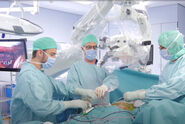Benefits of Surgical Video Training
Learning in neurosurgery is mostly based on mentorship. However, Dr. Troude says, this traditional method of teaching faces many limitations: it mostly comes down to watch and learn, there isn’t much time and there is more and more knowledge to integrate due to the evolution of surgical techniques. There are also medico-legal issues, for example if a resident operates a patient who then faces complications.
Neurosurgery has a steep learning curve and it is essential to develop tools to initiate the learning curve, in particular through simulation-based learning. This led to the creation of the Serious Game in Intraoperative Neurosurgery (SGION), a step-by-step real-life surgical video training. With this tool, students can step into the surgeon’s shoes and move forward in the surgery by making technical choices at each step of the procedure.
How to Build Surgical Video Training
To build a surgical video training for the SGION, the first step is planning, with the choice of the surgical procedure that will be recorded. It doesn’t have to be a challenging procedure, as students also need to master simple procedures, but it needs to be specific and recurrent. There are several requirements that need to be taken into account: time for preparation and surgery, teamwork, the creation of a script beforehand and working with a video technician to edit the video.
For the recording, Dr. Troude continues explaining, it is essential to have a high-quality optics microscope with a 2D video recorder or a Leica GLOW 3D camera. Dr. Troude uses the Leica M530 OHX surgical microscope, with GLOW800 Augmented Reality. The video editing can be done with any video editing software to make pre-selections and a voice recorder to create the voice over. Then, the video technician transforms the video into a game. Ideally, the videos shouldn’t be too long, with a duration of 10 to 15 minutes for the more complex surgeries.
When publishing the video, it is important to make sure it is easily accessible. The SGION can be accessed at any time through any device on the website of the French College of Neurosurgery.
At the end of the game, students are evaluated and receive a rating based on an evaluation grid. It is easy to follow student progress, through indicators such as the percentage of correct answers. In the future, the SGION could be used as a learning validation tool.
Surgical Video Training Example
The first SGION module developed was around unruptured cerebral artery aneurysm exclusion by clipping. The aneurysm was discovered in a 35-year-old patient, after a traumatic head injury. Through the SGION surgical video, the student is taken through the procedure and is asked to make surgical decisions at every step.
After making a decision, the student sees the right approach, with the voice over providing the explanation and advice. This tool helps students understand the questions they must ask themselves when operating, supporting decision-making. They can repeat the game as many times as they want and use it as a reference.
For teachers, according to Dr. Troude, the SGION is a new and fresh neurosurgery teaching tool, which can be declined for many surgical procedures. It can also help identify the critical teaching points to redirect learning programs.
The team is currently working on creating new SGION modules and looking for the contribution from other centers according to their specialties.
Want to learn more? Register to watch the webinar presented by Dr. Lucas Troude and see the full demo of the SGION.
Note: The statements of the healthcare professional in this video reflect only his opinion and personal experience. His statements do not necessarily reflect the opinion of any institution with whom he is affiliated. Please check with your local Leica Microsystems representative for product registration status in your region.





